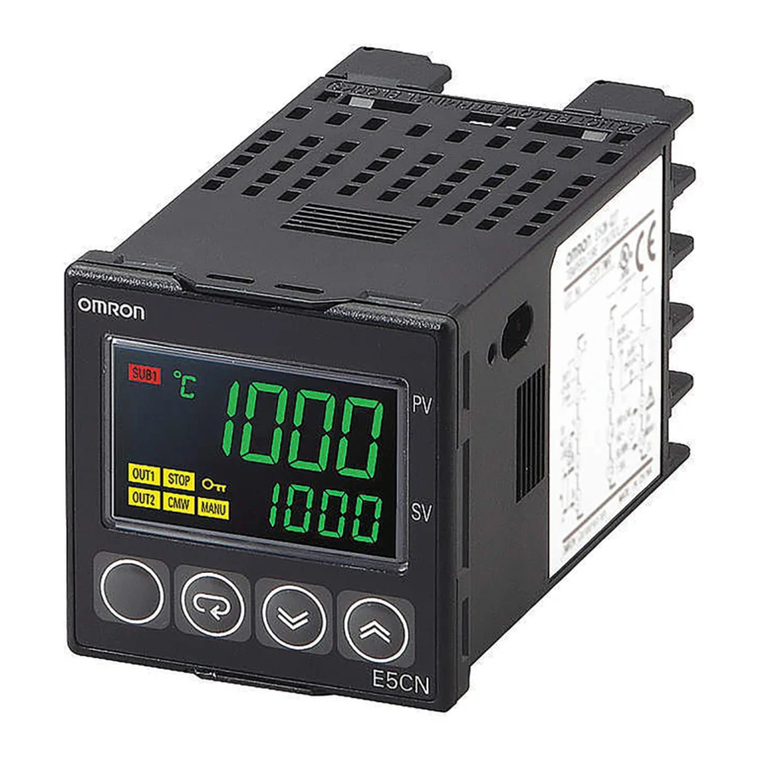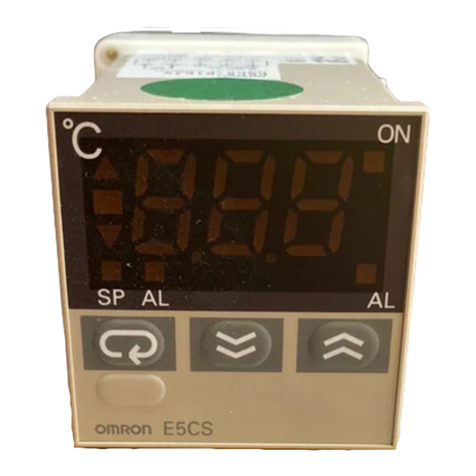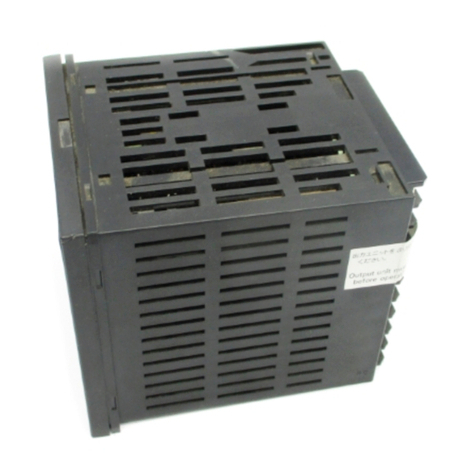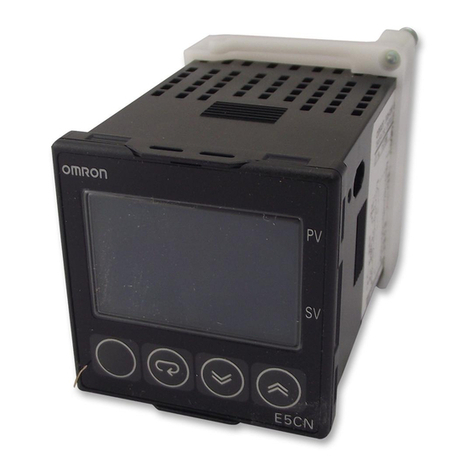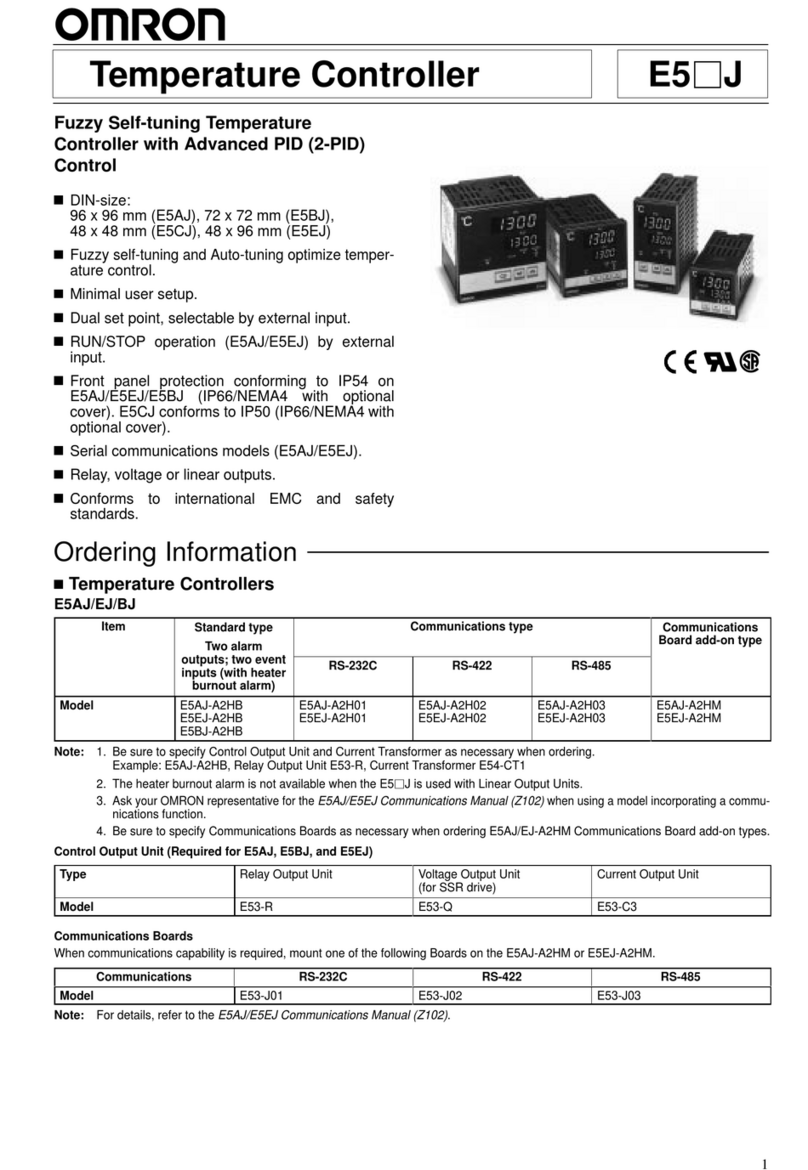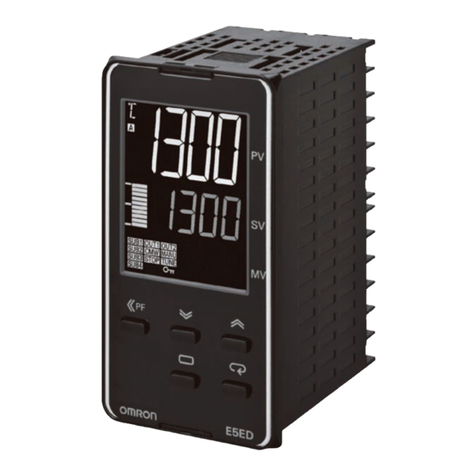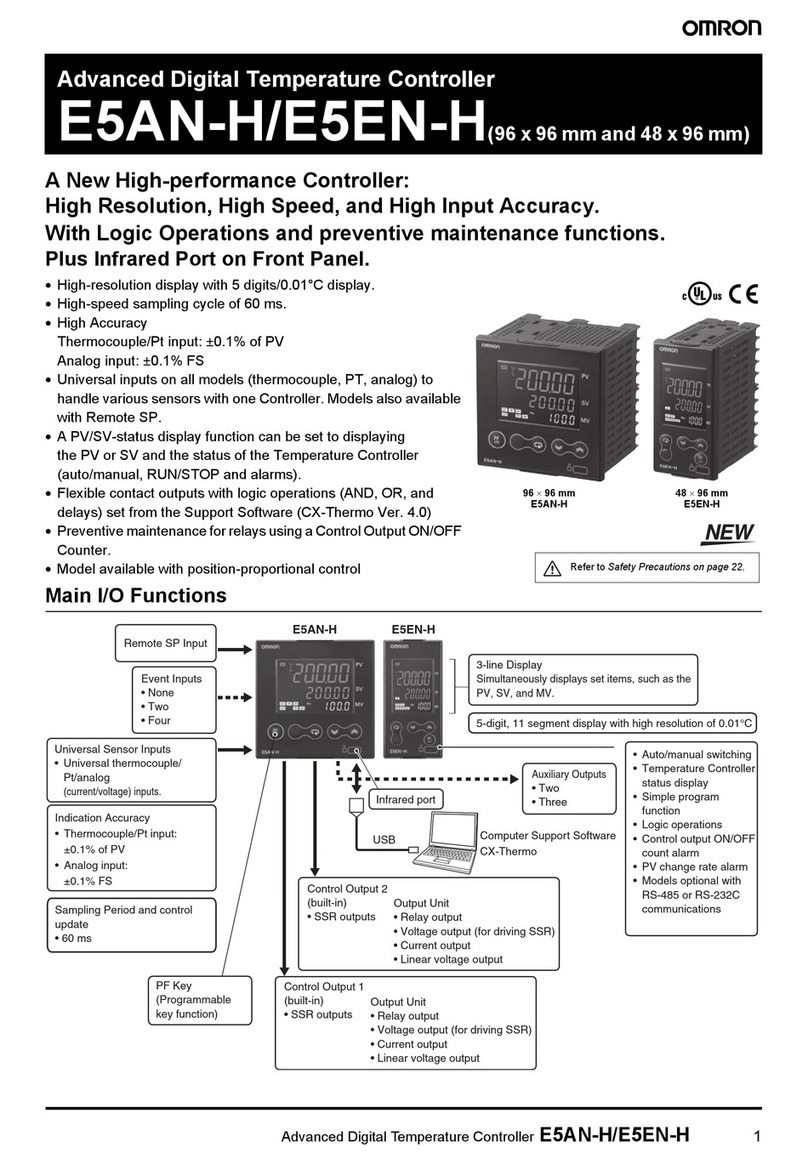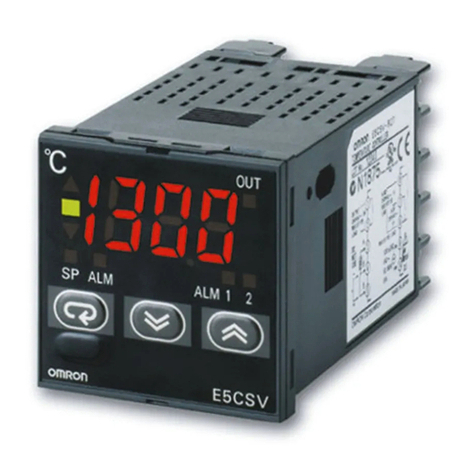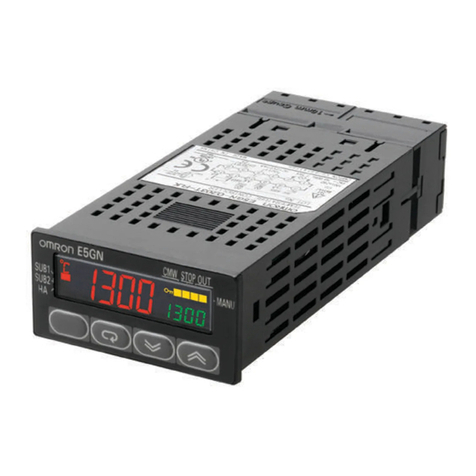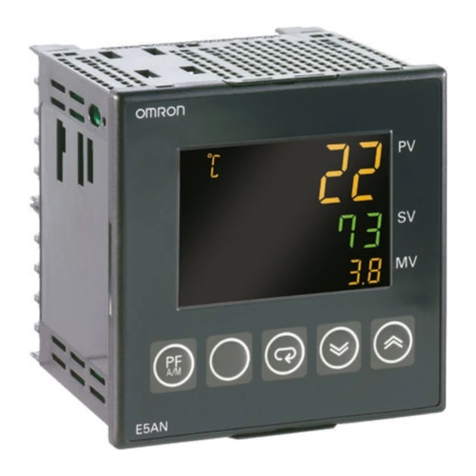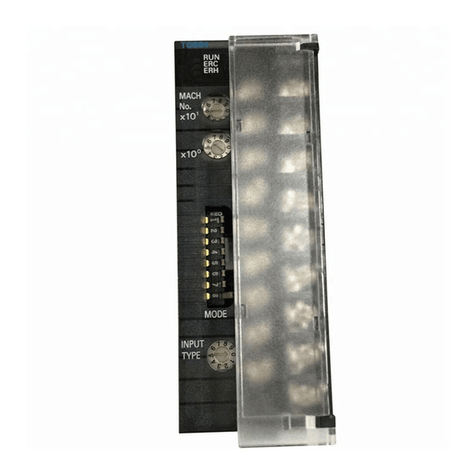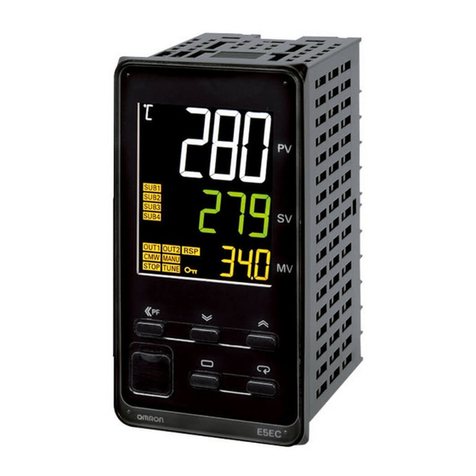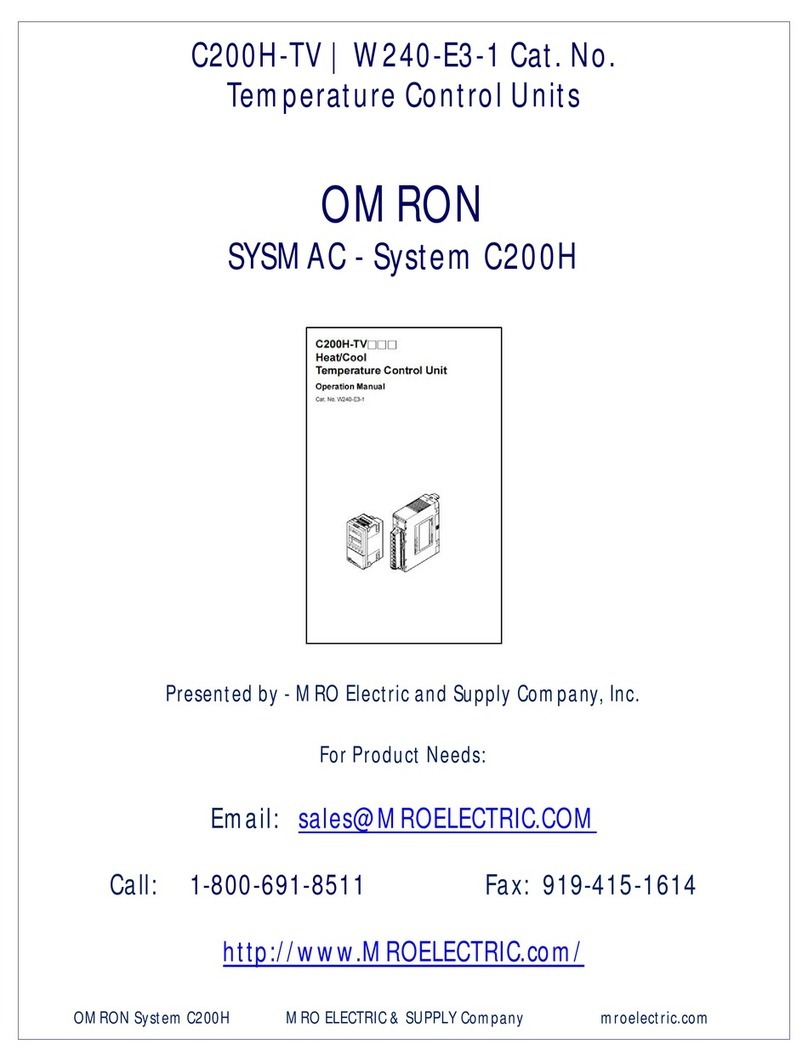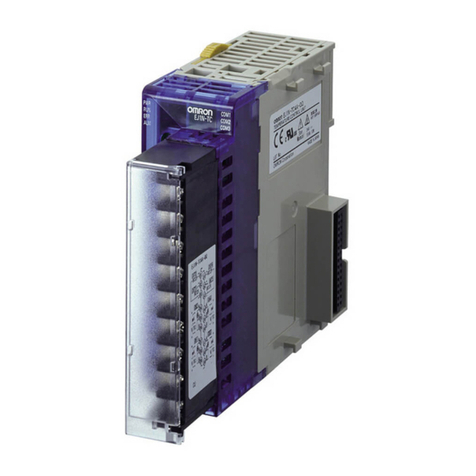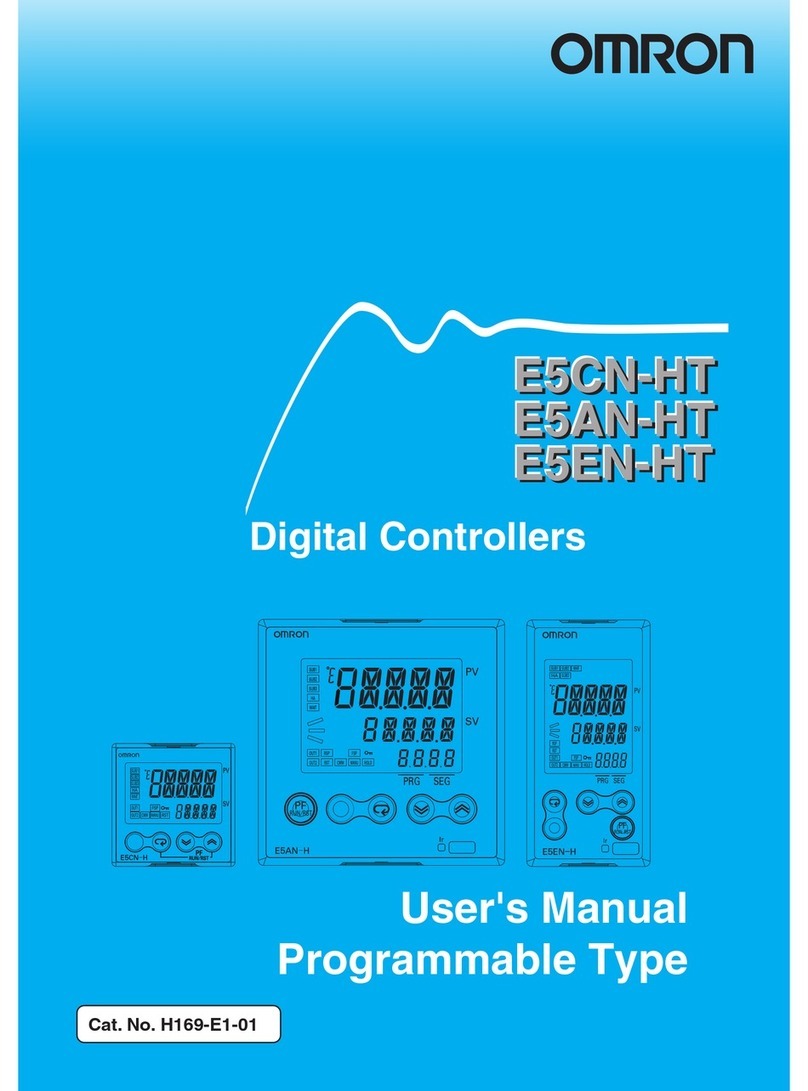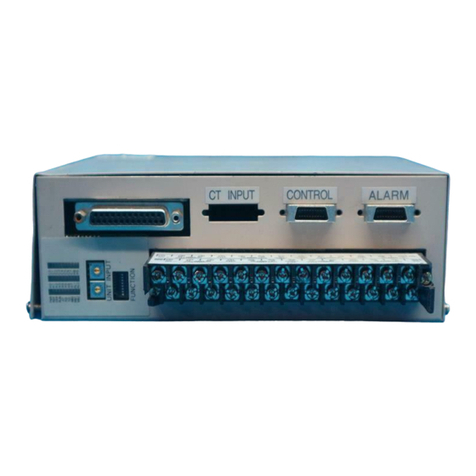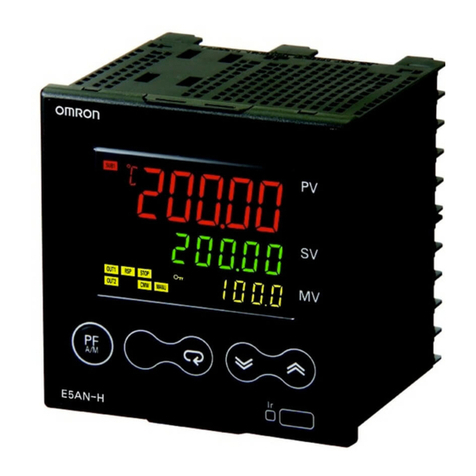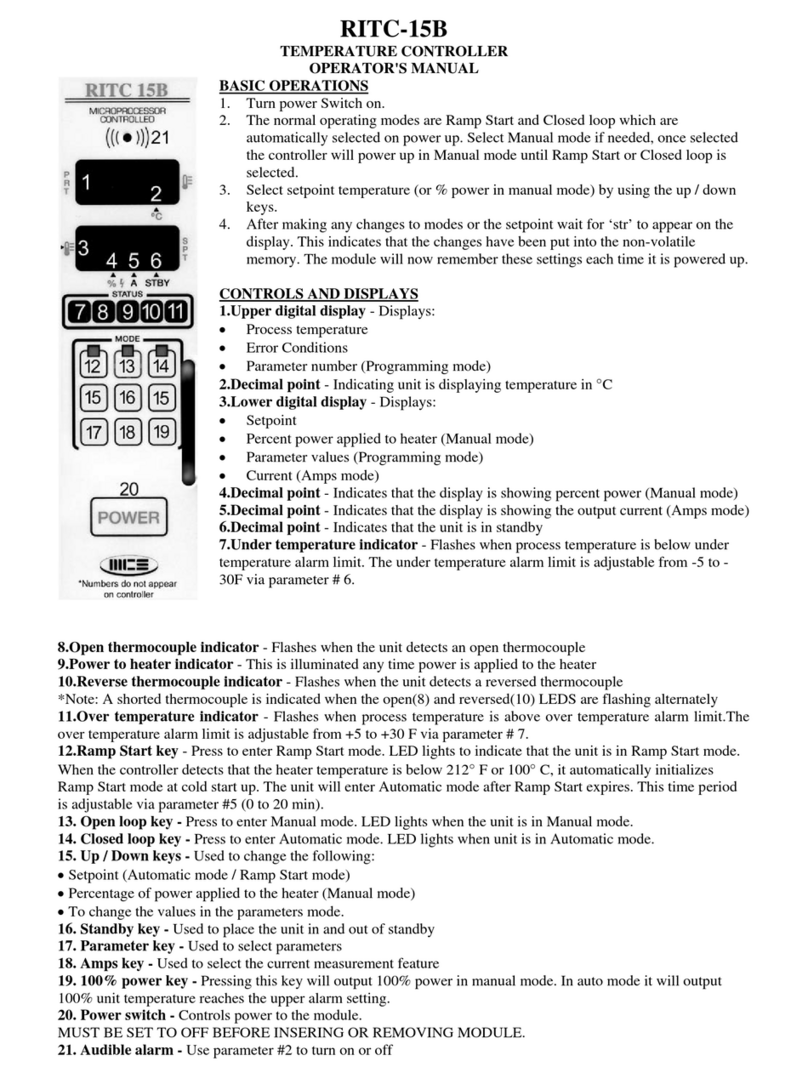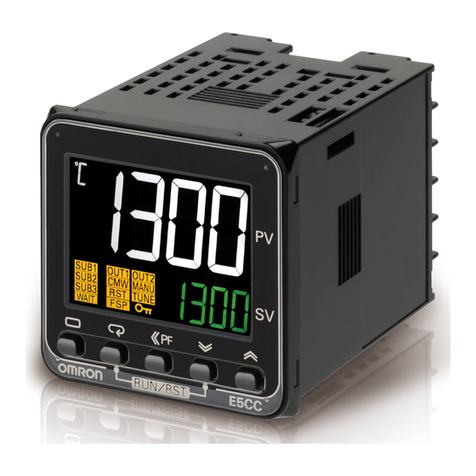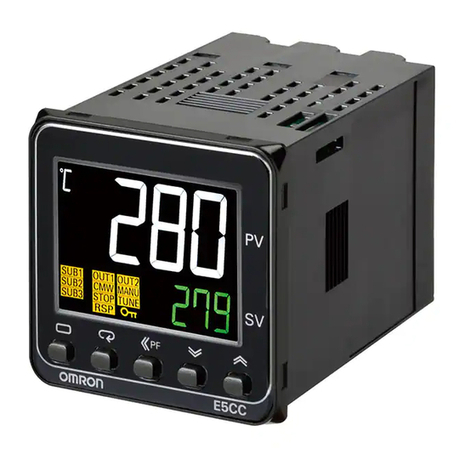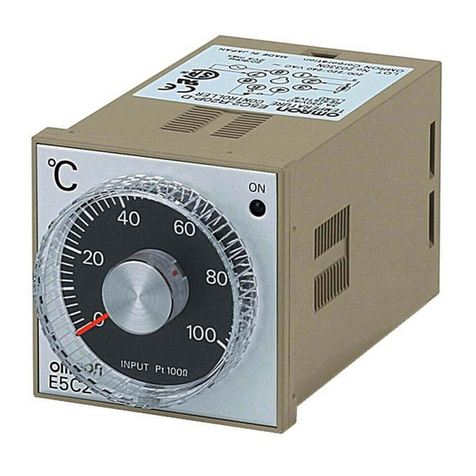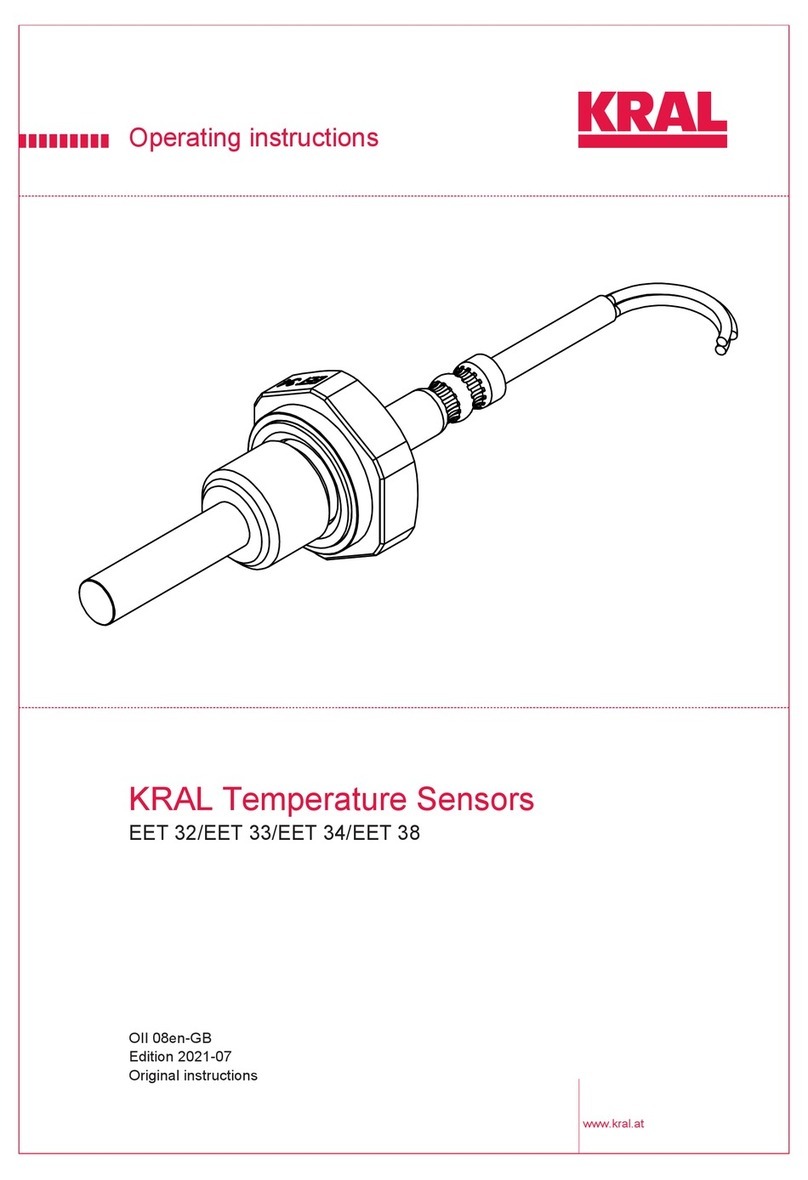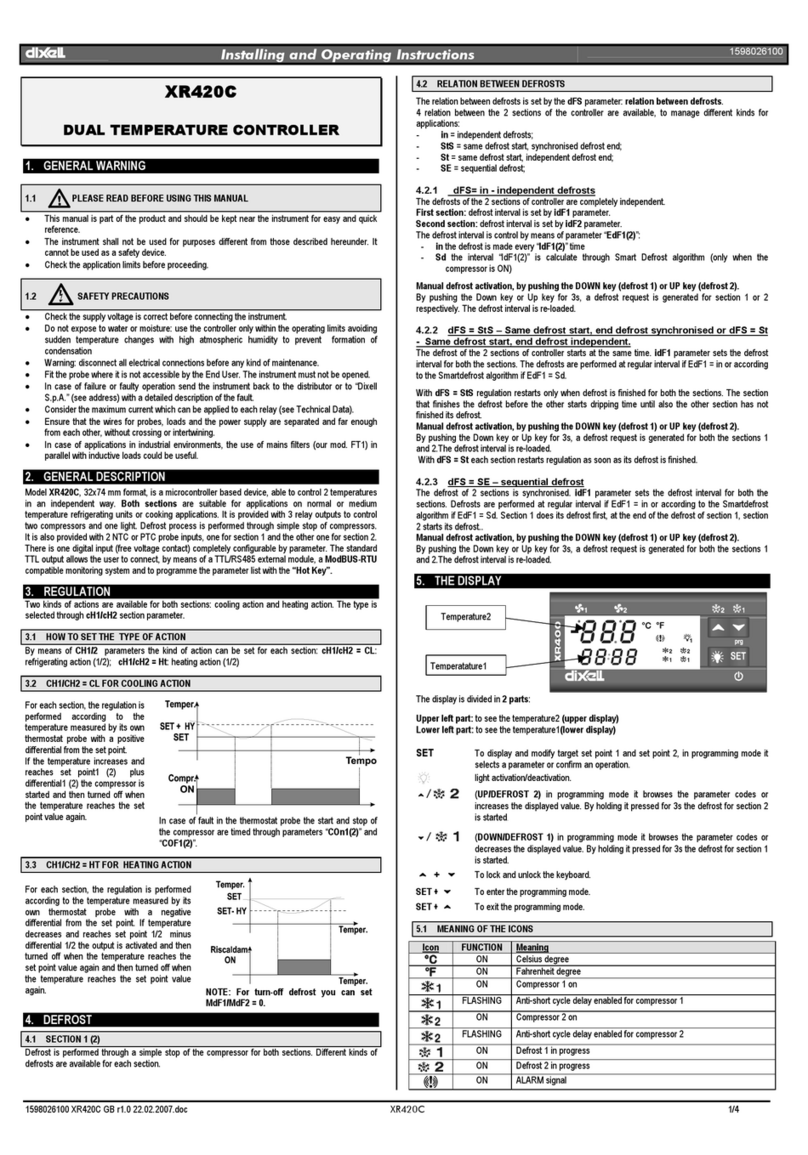
POWER ON
OMRON EUROPE B.V.
Wegalaan 67-69, NL-2132 JD Hoofddorp The Netherlands
Phone 31-2356-81-300
FAX 31-2356-81-388
OMRON ELECTRONICS LLC
One Commerce Drive Schaumburg, IL 60173-5302 U.S.A
Phone 1-847-843-7900
FAX 1-847-843-7787
OMRON ASIA PACIFIC PTE. LTD.
No. 438A Alexandra Road # 05-05/08 (Lobby 2),
Alexandra Technopark, Singapore 119967
Phone 65-6835-3011
FAX 65-6835-2711
OMRON Corporation
Shiokoji Horikawa, Shimogyo-ku, Kyoto 600-8530 JAPAN
E5CS-U
Safety Precautions
Key to Warning Symbols
CAUTION
Precautions for Safe Use
Installation Diagrams
Flush mounting (Panel cutout)
Surface mounting
Individual mounting (mm) Side-by-side mounting
(waterproof not possible) (mm)
(48 x number of units -2.5)
+1
0
+0.6
0
45
+0.6
0
45
Recommended panel thickness
is 1 to 4 mm.
E5CS-R@U, -Q@U (No alarm output type)
Suitable socket is P2CF-08-@or P3G-08
E5CS-R1@U, -R2@U, -Q1@U, -Q2@U (Alarm output type)
Suitable socket is P2CF-11-@or P3GA-11
Control output
· Voltage output
12V DC 21mA
· Relay output
1c 250V AC 3A
(resistive load)
Control output
· Voltage output
12V DC 21mA
· Relay output
1c 250V AC 3A
(resistive load)
Operation
Suitability for Use
Conformance to Safety Standards
Reinforced insulation is provided between input power supply, relay outputs, and between other
terminals.
Instruction Manual
OMRON Corporation
All Rights Reserved
©
Conformance to EN/IEC Standards
This is a class A product. In residential areas it may cause radio interference, in which case the user may be required
to take adequate measures to reduce interference.
English
Thank you for purchasing the OMRON E5CS-U
Temperature Controller. This manual describes the
functions, performance, and application methods needed
for optimum use of the product.
Please observe the following items when using the
product.
• This product is designed for use by qualified personnel
with a knowledge of electrical systems.
• Before using the product, thoroughly read and
understand this manual to ensure correct use.
• Keep this manual in a safe location so that it is available
for reference whenever required.
Warning Symbols
CAUTION
Do not touch the terminals while power is being supplied.
Doing so may occasionally result in minor injury due to electric shock.
Do not allow pieces of metal, wire clippings, or fine metallic shavings or filings from installation to enter the product. Doing so
may occasionally result in electric shock, fire, or malfunction.
Do not use the product where subject to flammable or explosive gas. Otherwise, minor injury from explosion may
occasionally occur.
Never disassemble, modify, or repair the product or touch any of the internal parts. Minor electric shock, fire, or malfunction
may occasionally occur.
CAUTION - Risk of Fire and Electric Shock
a) This product is UL listed as Open Type Process Control Equipment. It must be mounted in an enclosure that does not
allow fire to escape externally.
b) More than one disconnect switch may be required to de-energize the equipment before servicing.
c) Signal inputs are SELV, limited energy.
d) Caution: To reduce the risk of fire or electric shock, do not interconnect the outputs of different Class 2 circuits.
If the output relays are used past their life expectancy, contact fusing or burning may occasionally occur. Always consider
the application conditions and use the output relays within their rated load and electrical life expectancy. The life
expectancy of output relays varies considerably with the output load and switching conditions.
Tighten the terminal screws to 0.50 N·m. Loose screws may occasionally result in fire.
Unexpected operation may result in equipment damage or accidents if the settings are not appropriate for the controlled
system. Set the Temperature Controller as follows:
· Set the parameters of the Temperature Controller so that they are appropriate for the controlled system.
·
Turn the power supply to the Temperature Controller OFF before changing any switch setting.
Switch settings are read only when the power supply is turned ON.
·
Make sure that the INIT switch in the control mode selector switches is turned OFF before operating the Temperature
Controller.
A malfunction in the Digital Controller may occasionally make control operations impossible or prevent alarm outputs,
resulting in property damage. To maintain safety in the event of malfunction of the Temperature Controller, take appropriate
safety measures, such as installing a monitoring device on a separate line.
Indicates a potentially hazardous situation which, if
not avoided, is likely to result in minor or moderate
injury or property damage. Read this manual
carefully before using the product.
Be sure to observe the following precautions to prevent operation failure, malfunction, or adverse affects on the
performance and functions of the product. Not doing so may occasionally result in unexpected events.
1) The product is designed for indoor use only. Do not use the product outdoors or in any of the following locations.
·Places directly subject to heat radiated from heating equipment.
·Places subject to splashing liquid or oil atmosphere.
·Places subject to direct sunlight.
·Places subject to dust or corrosive gas (in particular, sulfide gas and ammonia gas).
·Places subject to intense temperature change.
·Places subject to icing and condensation.
·Places subject to vibration and large shocks.
2) Use/store within the rated temperature and humidity ranges. Provide forced-cooling if required.
3) To allow heat to escape, do not block the area around the product.
Do not block the ventilation holes on the product.
4) Use specified size (M3.5, width 7.2 mm or less) crimped terminals for wiring. To connect bare wires to the terminal
block, use copper braided or solid wires with a gage of AWG24 to AWG18 (equal to a cross-sectional area of 0.205
to 0.832 mm2). (The stripping length is 5 to 6 mm.). Up to two wires of same size and type, or two crimped terminals
can be inserted into a single terminal.
5) Be sure to wire properly with correct polarity of terminals.
Do not wire any of the I/O terminals incorrectly.
6) Do not wire the terminals which are not used.
7)
The voltage output (control output) is not electrically isolated from the internal circuits. When using a grounded temperature sensor,
do not connect any of the control output terminals to ground. Otherwise unwanted current paths will cause measurement errors.
8)
Allow as much space as possible between the controller and devices that generate a powerful high-frequency or surge.
Separate the high-voltage or large-current power lines from other lines, and avoid parallel or common wiring with the
power lines when you are wiring to the terminals.
9) Use this product within the rated load and power supply.
10) Make sure that the rated voltage is attained within two seconds of turning ON the power using a switch or
relay contact. If the voltage is applied gradually, the power may not be reset or output malfunctions may occur.
11) When using PID operation (self-tuning), turn ON the power supply to the load at the same time or before turning the
power supply to the Temperature Controller ON.
12) Design system (control panel, etc) considering the 2 second of delay that the controller’s output to be set after
power ON.
13) A switch or circuit breaker should be provided close to this unit. The switch or circuit breaker should be within easy
reach of the operator, and must be marked as a disconnecting means for this unit.
14) Make sure that the Controller has 30 minutes or more to warm up after turning ON the power before starting actual
control operations to ensure the correct temperature display.
15)
Be sure that the platinum resistance thermometer type and the input type set on the Temperature Controller are the same.
16) When extending the thermocouple lead wires, always use compensating conductors suitable for the type of
thermocouple. Do not extend the lead wires on a platinum resistance thermometer. Use only low-resistance wire
(5 Ωmax. per line) for lead wires and make sure that the resistance is the same for all three wires.
17)
Static electricity can damage internal components. Always touch grounded metal to discharge any static electricity before
handling the Temperature Controller. When drawing out the controller from the case, do not touch the electronic components
or patterns on the board with your hand. Hold the Temperature Controller by the edge of the front panel when handling it.
18) Do not use paint thinner or similar chemical to clean with. Use standard grade alcohol.
19) Use tools when separating parts for disposal.
Dimensions
Names of Front Parts
Setting
In the pack:
·Main unit
·Mounting bracket
·Instruction manual
·°C/°F labels, Specifications entry label *1
*1 When changing the display unit,
attach the °C/°F label over the previous
°C/°F label. Enter the settings on the
specifications entry label and use it to manage
the settings.
+0.6
0
45
60min.
· Insert the controller through the hole in the panel. Push the mounting
bracket on from the rear and fasten temporarily, removing any gap
between the controller, panel and mounting bracket. Finally, secure
two fixing screws alternately keeping the torque to between 0.29 to
0.39 N·m.
Refer to the dimension diagram for the mounting status.
· When mounting more than one Temperature Controller, be sure that
the heat generated by the Temperature Controllers does not cause
the ambient temperature to exceed the specified value.
· Close side-by-side mounting is possible in one direction only, either
When mounting plural units in vertical arrangement, leave space of
approx. 20 mm above and below the mounting socket.
E5CS-U (mm)
Terminal Layout
Do not use
Do not
use
Do not
use
Thermistor
Thermocouple
Platinum resistance thermometer
Input power supply
· 100 to 240 V AC type
· 24 V AC/DC type
(no polarity)
Do not
use
Do not
use
Do not use
Alarm output (relay output)
250V AC 1A (resistive output)
Alarm 1 Alarm 1
Alarm 2
Do not use
Input power supply
· 100 to 240 V AC type
· 24 V AC/DC type
(no polarity)
Thermocouple
Thermistor
Platinum resistance thermometer
Display
Switch
Mode indicators
Mode key
Protection switch
Alarm mode
selector switch *1
INIT switch *2
Down key
Front door
LED deviation
indicators
Temperature
indicator
Output operation
indicator
Alarm output
operation
indicator
Up key
Front door
open/close notch
Pull forward on the front door open/close notch on the right of the front
panel to open the front door.
Open the front door only when setting the switches. Do not open it at
any other time.
Control mode
selector switch Temperature range
selector switch
*1 There is no alarm mode selector switch on models without an alarm.
*2 The INIT switch is always OFF.
* The default is “2”. * The default is “3”. * The default is “1”. * The default is “0”.
Control mode selector switch No.5: OFF
Control mode selector switch No.5: ON
Temperature indicator
The present temperature, set temperature, alarm set
temperature, or input shift value is displayed.
LED deviation indicators
: Lit when the difference between the present
temperature and the set temperature is larger
than +1% FS (+0.25% FS for TC/Pt multi-input
models).
: Lit when the difference between the present
temperature and the set temperature is within
±1% FS (±0.25% FS for TC/Pt multi-input
models).
: Lit when the difference between the present
temperature and the set temperature is smaller
than -1% FS (-0.25% FS for TC/Pt multi-input
models).
ST or AT will flash on the temperature indicator
when self-tuning or auto-tuning is being
performed.
Output operation indicator
OUT: Control output indicator
Lit when the output function is ON; not lit when the
output function is OFF.
Alarm output operation indicator
ALM1: Alarm 1 indicator
Lit when the alarm 1 function is ON.
ALM2: Alarm 2 indicator
Lit when the alarm 2 function is ON.
Mode indicators
SP: Lit when the set temperature is displayed.
ALM: Lit when the alarm set temperature is displayed.
Mode key
Switches the display between the present
temperature, set temperature, alarm set temperature,
and input shift value.
Up key / Down key
The set temperature, alarm set temperature, or input
shift value will increase when the Up Key is pressed.
The set temperature, alarm set temperature, or input
shift value will decrease when the Down Key is
pressed.
Protection switch
· The protection switch can be turned ON to disable the Up and
Down keys and prevent setting mistakes.
· The Mode key, however, will operate even when the protection
switch is ON (i.e., the display can be switched between the
present temperature, set temperature, alarm set temperature,
and input shift value).
· The default is “OFF”.
Step1 Step2
Set the operating specifications with the switches. Set the control
temperature.
Control mode selector switch Alarm mode selector switch
Temperature range selector switch
· All switches are OFF by default.
· Hysteresis is 0.2% FS (0.1% FS for TC/Pt multi-input models) when ON/OFF
control is selected.
· The PID parameters are automatically set for optimum control by ST (self-tuning)
when 2-PID control is selected.
· The input shift values will be effective even when the input shift is not displayed
(i.e., when displaying the input shift is disable).
To disable the input shift, set the input shift value to H0. The default setting is H0.
· The setting of switch 5 will not affect operation if a thermistor model is used.
· Thermocouple type
(E5CS-@KJU)
· Platinum resistance thermometer type
(E5CS-@PU)
· Thermistor type
(E5CS-@GU)
· Thermocouple/platinum resistance
thermometer (multi-input)
(E5CS-@TU)
* For alarms 1 to 7, set the alarm value
(X) to the deviation from the set point.
For alarm 8, set the alarm value (Y) to
the absolute value from 0°C/°F.
* The default is “2” (Deviation upper limit).
* The only type of alarm supported for
alarm 2 is an upper limit alarm.
Temperature
indication
Present
temperature *1
Set temperature
SP indicator lit.
Alarm value 1 *2
ALM indicator lit.
Input shift value *3
Alarm value 2 *2
ALM indicator flashes.
*1 To start AT (auto-tuning), press and hold the
Up and Down keys simultaneously for at least
2 seconds while the temperature is displayed
on the temperature indicator.
*2 Displayed only for models with alarms.
When alarm mode selector switch is set to 0
or 9, no alarm temperature is displayed.
The only type of alarm supported for Alarm 2
is an upper limit alarm.
*3 Input shift value is not displayed when pin 4 of
control mode selector switch is set to OFF.
Specifications
Power supply voltage 100 to 240V AC type 50/60Hz
24V AC type 50/60Hz / 24V DC type
Operating voltage range 85 to 110% of the rated voltage
Power consumption Approx. 5VA (100 to 240V AC)
Approx. 3VA (24V AC) / Approx. 2W (24V DC)
Indication accuracy Thermocouple type
(Ambient temperature:23°C) (±1.0% of indication value or ±2°C, which is greater)
±1 digit max.
Platinum resistance thermometer type
(±0.5% of indication value or ±1°C, which is greater)
±1 digit max.
Thermistor type
1.0% FS ±1 digit max.
Control output Relay output: 250V AC 3A (resistive load)
Voltage output: 12V DC 21mA
Electrical life of relay: 100,000 operations
Control method ON/OFF or 2-PID control
Alarm output Relay output: 250V AC 1A (resistive load)
Electrical life of relay: 100,000 operations
Ambient temperature -10 to 55°C
(Avoid freezing or condensation)
Ambient humidity 25 to 85%
Storage temperature -25 to 65°C
(Avoid freezing or condensation)
Altitude Max. 2,000m
Recommended fuse T2A 250V AC,time-lag, low-breaking capacity
Weight Approx.110g (main unit only)
Degree of protection
Front panel: IP50, Enclosure Category 2 (as per IEC60529),
Rear case: IP20,
Terminal section: IP00
Installation environment Installation category II, pollution degree 2
(as per IEC61010-1)
Memory protection Non-volatile memory
(Number of write operations: 1,000,000)
Terminal Filed wiring terminal
(with P2CF-08 or P2CF-11)
Applicable Connection Sockets
Sockets for no Alarm (8-pin):
(Order Separately) P2CF-08, P2CF-08-E, and P3G-08
Sockets for Alarm (11-pin):
P2CF-11, P2CF-11-E, and P3GA-11
SELF-DIAGNOSTIC FUNCTION
If an error occurs, it will be displayed on the temperature display.
Check the type of error and correct the error accordingly.
If the input value exceeds the display limit (-99 to 1999), though it is within the control range, [[[ will be
displayed under -99 and ]]] above 1999.
Under these conditions, control output and alarm output will operate normally.
*1 Alarm output (Models with alarm output type only)
·
The alarm output will operate as an abnormally high temperature alarm output when
fff
is displayed (flashes).
·
The alarm output will operate as an abnormally low temperature alarm output when
---
is displayed (flashes).
· The alarm output will turn OFF when e11 is displayed.
*2 Errors are displayed only when the present temperature is being displayed.
Errors will not be displayed if the set temperature, alarm set temperature, or input shift value is displayed.
Overflow and underflow are not applicable to TC/Pt multi-input models.
*3 Sensor error detection function is not provided for thermistor type.
Display Error Meaning Action Control output
Reverse Normal
· The temperature has risen beyond the set temperature range.
· With Thermistor types, the sensor is shorted.
· The temperature has risen beyond the overflow temperature.
·
The thermocouple or platinum resistance thermometer has failed.
· TC/Pt multi-input modes: A temperature sensor error has
occurred at a temperature higher than the set temperature range.
· The temperature has fallen below the underflow temperature.
·
The polarity (positive and negative) of thermocouple has been reserved.
· The platinum resistance thermometer has failed.
· TC/Pt multi-input modes: A temperature sensor error has
occurred at a temperature higher than the set temperature range.
· The temperature has fallen below the set temperature range.
· With Thermistor types, the sensor is disconnected.
Memory has failed.
Check the wiring of inputs,
disconnections, shorts and
input type.
After the correction of input
error, turn the power OFF
then back ON again.
Overflow
*1, *2
Underflow
*1, *2
Sensor error
*1, *3
Memory error
(flashing)
(flashing)
OMRON shall not be responsible for conformity with any standards, codes, or regulations that apply to the combination of the
products in the customer's application or use of the product. Take all necessary steps to determine the suitability of the product for
the systems, machines, and equipment with which it will be used. Know and observe all prohibitions of use applicable to this product.
NEVER USE THE PRODUCTS FOR AN APPLICATION INVOLVING SERIOUS RISK TO LIFE OR PROPERTY WITHOUT
ENSURING THAT THE SYSTEM AS A WHOLE HAS BEEN DESIGNED TO ADDRESS THE RISKS, AND THAT THE OMRON
PRODUCT IS PROPERLY RATED AND INSTALLED FOR THE INTENDED USE WITHIN THE OVERALL EQUIPMENT OR
SYSTEM. See also product catalog for Warranty and Limitation of Liability.
Input Setting Setting range
°C °F
0
1
2
3
4
5
6
7
8
9
Input Setting Setting range
°C °F Input Setting Setting range
°C °F Input Setting Setting range
°C °F
Input Setting Setting range
°C °F
0
1
2
3
4
5
6
7
8
9
0
1
2
3
4
5
6
7
8
9
K JPt100,
Pt100
G0
1
2
3
4
5
6
7
8
9
0
1
2
3
4
5
6
7
8
9
Pt100
JPt100
J, L
0 to 200
0 to 300
0 to 400
0 to 500
0 to 600
0 to 999
0 to 200
0 to 300
0 to 400
0 to 500
-50 to 50
0.0 to 50.0
-20 to 80
0.0 to 99.9
0 to 200
0 to 300
0 to 400
0 to 300
0 to 400
0.0 to 199.9
-50 to 50
0 to 100
50 to 150
100 to 200
150 to 300
-50 to 50
0 to 100
50 to 150
100 to 200
150 to 300
-99 to 850
0.0 to 199.9
-99 to 99
0 to 200
0 to 400
-99 to 500
0.0 to 199.9
-99 to 99
0 to 200
0 to 400
-99 to 1500
0.0 to 199.9
-99 to 99
0 to 200
0 to 400
-99 to 900
0.0 to 199.9
-99 to 99
0 to 200
0 to 400
-50 to 100
0 to 200
100 to 300
200 to 400
300 to 600
-50 to 100
0 to 200
100 to 300
200 to 400
300 to 600
-50 to 50
0.0 to 50.0
-20 to 80
0.0 to 99.9
0 to 200
0 to 300
0 to 400
0 to 600
0 to 800
0.0 to 199.9
0 to 200
0 to 300
0 to 400
0 to 500
0 to 600
0 to 999
0 to 999
0 to 300
0 to 400
0 to 500
-99 to 1300
0.0 to 199.9
-99 to 850
0.0 to 199.9
-99 to 850
-99 to 400
0.0 to 199.9
-99 to 400
-99 to 1300
0 to 1700
-99 to 1999
0.0 to 199.9
-99 to 1500
0.0 to 199.9
-99 to 1500
-99 to 700
0.0 to 199.9
-99 to 700
-99 to 1990
0 to 1990
SW No.
Alarm type Alarm output
No alarm function
Deviation
upper/lower limit
Deviation
upper/lower limit
standby sequence ON
Deviation upper
limit standby
sequence ON
Absolute value
upper limit
Deviation lower
limit standby
sequence ON
Deviation
upper/lower range
Deviation
lower limit
Deviation
upper limit
Switch
°C °F
Function OFF ON
PID ON/OFF ON/OFF control 2-PID control
20 seconds 2 seconds
Reverse Normal
Disable Enable
Control period
Forward/reverse operation
Input shift
Selection
Thermometer
replacement
Thermocouple: K, J Thermocouple: K, L
Multi-input: Thermocouple
Platinum resistance
thermometer: JPt100
Platinum resistance thermometer: Pt100
Multi-input: Platinum resistance
thermometer
1
2
3
4
5
6
0,9
1
3
4
5
6
7
8
2
K
J
L
T
U
N
R
Output off
Temperature Controller
OFF
ON
OFF
OFF
OFF
ON
OFF
OFF
OFF
OFF
Screw
Duct and etc.
Hook
P2CF-@
Panel
(mm)
fff
e11
fff
---
---
Mounting bracket
48
(7.75)
6.25
94.45
72.5 14.2
44.8
58
